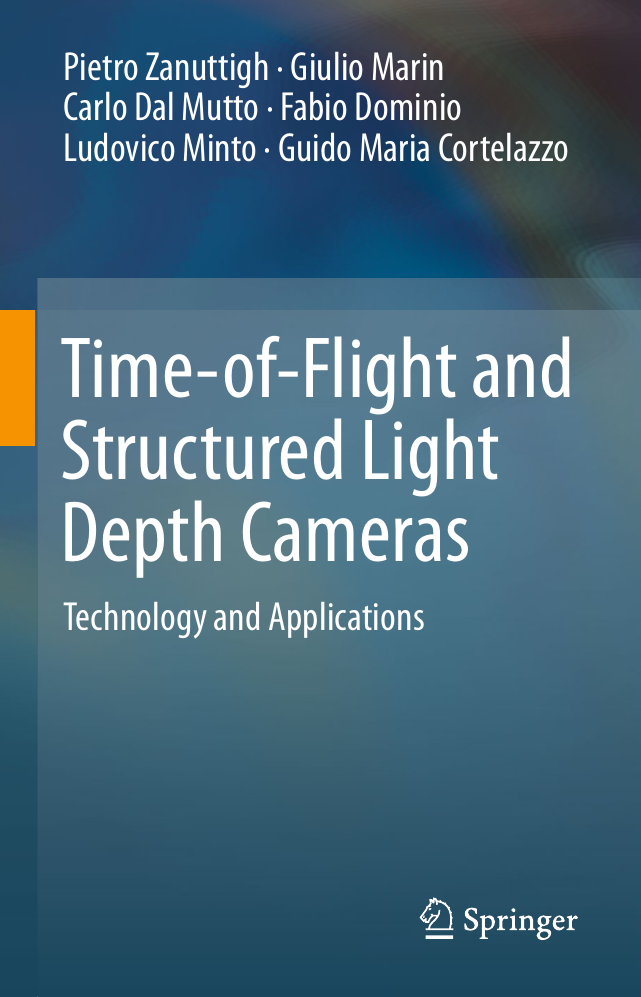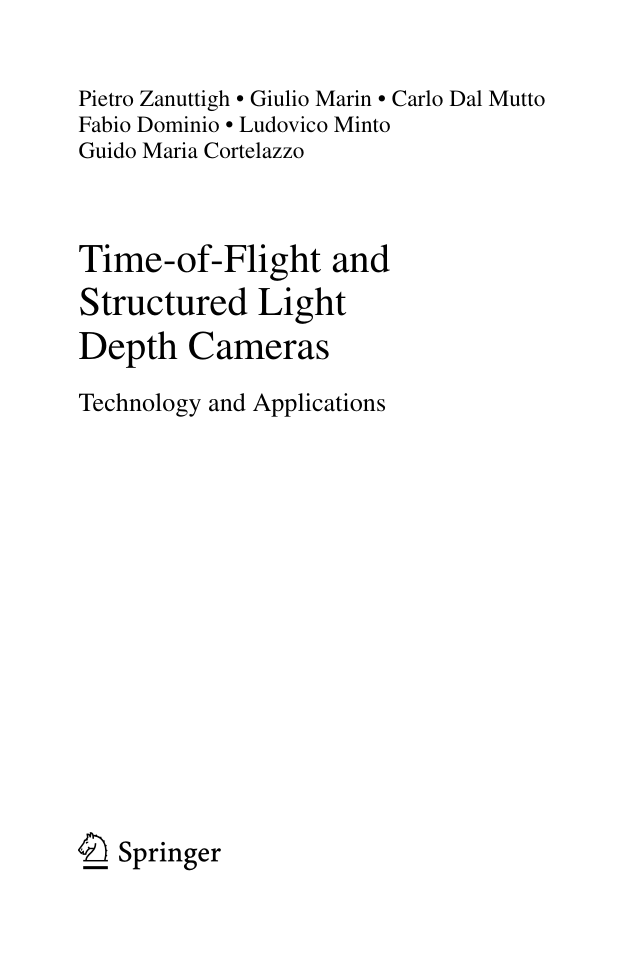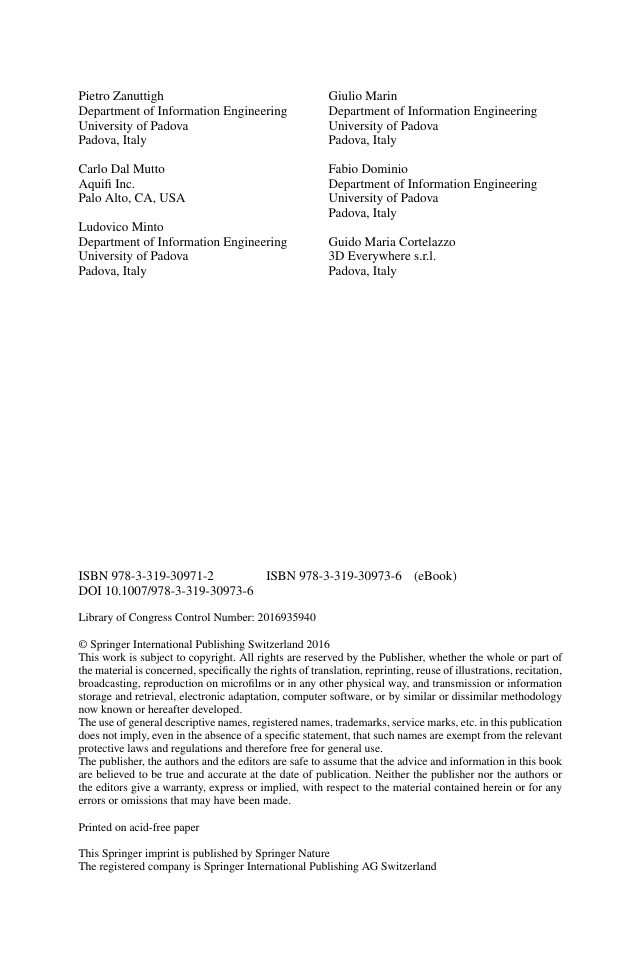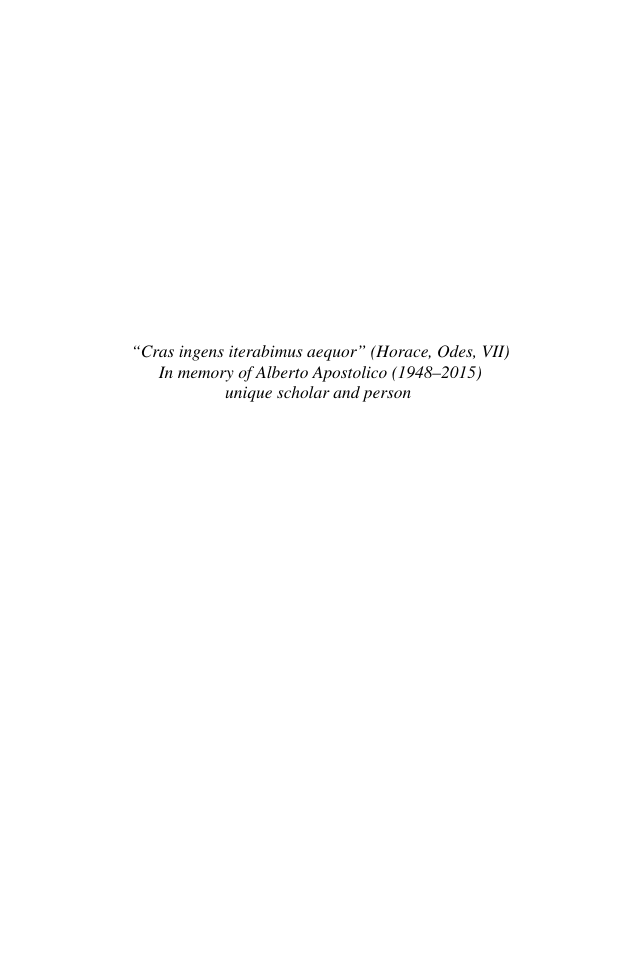Preface
Contents
1 Introduction
1.1 Basics of Imaging Systems
1.1.1 Pin-Hole Camera Model
1.1.2 Camera Geometry and Projection Matrix
1.1.3 Lens Distortions
1.2 Stereo Vision Systems
1.2.1 Two-view Stereo Systems
1.2.1.1 Epipolar Geometry
1.2.1.2 Epipolar Rectification
1.2.1.3 The Correspondence Problem
1.2.2 N-view Stereo Systems and Structure from Motion
1.2.3 Calibrated and Uncalibrated 3D Reconstruction
1.3 Basics of Structured Light Depth Cameras
1.4 Basics of ToF Depth Cameras
1.4.1 ToF Operation Principle
1.4.2 Direct ToF Measurement Methods
1.4.2.1 Direct Pulse Modulation
1.4.2.2 Direct CW Modulation
1.4.3 Surface Measurement by Single Point and Matricial ToF Systems
1.4.4 ToF Depth Camera Components
1.4.4.1 Modulation Methods for ToF Depth Cameras
1.4.4.2 ToF Depth Camera Transmitter Basics
1.4.4.3 ToF Depth Camera Receiver Basics
1.5 Book Overview
References
Part I Operating Principles of Depth Cameras
2 Operating Principles of Structured Light Depth Cameras
2.1 Camera Virtualization
2.2 General Characteristics
2.2.1 Depth Resolution
2.3 Illuminator Design Approaches
2.3.1 Implementing Uniqueness by Signal Multiplexing
2.3.1.1 Wavelength Multiplexing
2.3.1.2 Range Multiplexing
2.3.1.3 Temporal Multiplexing
2.3.1.4 Spatial Multiplexing
2.3.2 Structured Light Systems Non-idealities
2.4 Examples of Structured Light Depth Cameras
2.4.1 The Intel RealSense F200
2.4.2 The Intel RealSense R200
2.4.3 The Primesense Camera (AKA Kinect™ v1)
2.5 Conclusions and Further Reading
References
3 Operating Principles of Time-of-Flight Depth Cameras
3.1 AM Modulation Within In-Pixel Photo-Mixing Devices
3.1.1 Sinusoidal Modulation
3.1.2 Square Wave Modulation
3.2 Imaging Characteristics of ToF Depth Cameras
3.3 Practical Implementation Issues of ToF Depth Cameras
3.3.1 Phase Wrapping
3.3.2 Harmonic Distortion
3.3.3 Photon-Shot Noise
3.3.4 Saturation and Motion Blur
3.3.5 Multipath Error
3.3.6 Flying Pixels
3.3.7 Other Noise Sources
3.4 Examples of ToF Depth Cameras
3.4.1 Kinect™ v2
3.4.2 MESA ToF Depth Cameras
3.4.3 PMD Devices
3.4.4 ToF Depth Cameras Based on SoftKinetic Technology
3.5 Conclusions and Further Reading
References
Part II Extraction of 3D Information from Depth Cameras Data
4 Calibration
4.1 Calibration of a Generic Imaging Device
4.1.1 Measurement's Accuracy, Precision and Resolution
4.1.2 General Calibration Procedure
4.1.3 Supervised and Unsupervised Calibration
4.1.4 Calibration Error
4.1.5 Geometric Calibration
4.1.6 Photometric Calibration
4.2 Calibration of Standard Cameras
4.2.1 Calibration of a Single Camera
4.2.2 Calibration of a Stereo Vision System
4.2.3 Extension to N-View Systems
4.3 Calibration of Depth Cameras
4.3.1 Calibration of Structured Light Depth Cameras
4.3.2 Calibration of ToF Depth Cameras
4.4 Calibration of Heterogeneous Imaging Systems
4.4.1 Calibration of a Depth Camera and a Standard Camera
4.4.2 Calibration of a Depth Camera and a Stereo Vision System
4.4.3 Calibration of Multiple Depth Cameras
4.5 Conclusions and Further Readings
References
5 Data Fusion from Depth and Standard Cameras
5.1 Acquisition Setup with Multiple Sensors
5.1.1 Example of Acquisition Setups
5.1.2 Data Registration
5.2 Fusion of a Depth Camera with a Single Color Camera
5.2.1 Local Filtering and Interpolation Techniques
5.2.2 Global Optimization Based Approaches
5.3 Fusion of a Depth Camera with a Stereo System
5.3.1 Local Fusion Methods
5.3.1.1 Confidence Based Techniques
5.3.1.2 Probabilistic Approaches
5.3.2 Global Optimization Based Approaches
5.3.2.1 MAP-MRF Probabilistic Fusion Framework
5.3.2.2 Other Global Optimization Based Frameworks
5.3.3 Other Approaches
5.4 Conclusions and Further Reading
References
Part III Applications of Depth Camera Data
6 Scene Segmentation Assisted by Depth Data
6.1 Scene Matting with Color and Depth Data
6.1.1 Single Frame Matting with Color and Depth Data
6.1.2 Video Matting with Color and Depth Data
6.2 Scene Segmentation from Color and Depth Data
6.2.1 Single Frame Segmentation from Color and Depth Data
6.2.2 Single Frame Segmentation: Clustering of Multidimensional Vectors
6.2.3 Single Frame Segmentation: Graph-Based Approaches
6.2.4 Single Frame Segmentation Based on Geometric Clues
6.2.5 Video Segmentation from Color and Depth Data
6.3 Semantic Segmentation from Color and Depth Data
6.4 Conclusions and Further Reading
References
7 3D Scene Reconstruction from Depth Camera Data
7.1 3D Reconstruction from Depth Camera Data
7.2 Pre-processing of the Views
7.3 Rough Pairwise Registration
7.4 Fine Pairwise Registration
7.5 Global Registration
7.6 Fusion of the Registered Views
7.6.1 KinectFusion
7.7 Reconstruction of Dynamic Scenes
7.8 SLAM with Depth Camera Data
7.9 Conclusions and Further Reading
References
8 Human Pose Estimation and Tracking
8.1 Human Body Models
8.1.1 Articulated Objects
8.1.2 Kinematic Skeleton Models
8.1.3 Augmented Skeleton Models
8.2 Human Pose Estimation
8.2.1 Learning Based Approaches and the Kinect™ pose Estimation Algorithm
8.2.2 Example-Based Approaches
8.2.3 Point of Interest Detection
8.3 Human Pose Tracking
8.3.1 Optimization-Based Approaches
8.3.1.1 Local Optimization Methods
8.3.2 ICP and Ray Casting Approaches
8.3.3 Filtering Approaches
8.3.3.1 Pose Tracking with Particle Filter
8.3.3.2 Pose Tracking with Kalman Filter
8.3.4 Approaches Based on Markov Random Fields
8.4 Conclusions and Further Reading
References
9 Gesture Recognition
9.1 Static Gesture Recognition
9.1.1 Pose-Based Descriptors
9.1.2 Contour Shape-Based Descriptors
9.1.3 Surface Shape Descriptors
9.1.4 Area and Volume Occupancy Descriptors
9.1.5 Depth Image-Based Descriptors
9.1.6 Convex Hull-Based Descriptors
9.1.7 Feature Classification
9.1.8 Feature Selection
9.1.9 Static Gesture Recognition with Deep Learning
9.2 Dynamic Gesture Recognition
9.2.1 Deterministic Recognition Approaches
9.2.2 Stochastic Recognition Approaches
9.2.2.1 Dynamic Gesture Recognition with Hidden Markov Models
9.2.2.2 Dynamic Gesture Recognition with Hierarchical Markov Models
9.2.3 Dynamic Gesture Recognition with Action Graphs
9.2.4 Descriptors for Dynamic Gesture Recognition
9.3 Conclusions and Further Readings
References
10 Conclusions
Index
















 2023年江西萍乡中考道德与法治真题及答案.doc
2023年江西萍乡中考道德与法治真题及答案.doc 2012年重庆南川中考生物真题及答案.doc
2012年重庆南川中考生物真题及答案.doc 2013年江西师范大学地理学综合及文艺理论基础考研真题.doc
2013年江西师范大学地理学综合及文艺理论基础考研真题.doc 2020年四川甘孜小升初语文真题及答案I卷.doc
2020年四川甘孜小升初语文真题及答案I卷.doc 2020年注册岩土工程师专业基础考试真题及答案.doc
2020年注册岩土工程师专业基础考试真题及答案.doc 2023-2024学年福建省厦门市九年级上学期数学月考试题及答案.doc
2023-2024学年福建省厦门市九年级上学期数学月考试题及答案.doc 2021-2022学年辽宁省沈阳市大东区九年级上学期语文期末试题及答案.doc
2021-2022学年辽宁省沈阳市大东区九年级上学期语文期末试题及答案.doc 2022-2023学年北京东城区初三第一学期物理期末试卷及答案.doc
2022-2023学年北京东城区初三第一学期物理期末试卷及答案.doc 2018上半年江西教师资格初中地理学科知识与教学能力真题及答案.doc
2018上半年江西教师资格初中地理学科知识与教学能力真题及答案.doc 2012年河北国家公务员申论考试真题及答案-省级.doc
2012年河北国家公务员申论考试真题及答案-省级.doc 2020-2021学年江苏省扬州市江都区邵樊片九年级上学期数学第一次质量检测试题及答案.doc
2020-2021学年江苏省扬州市江都区邵樊片九年级上学期数学第一次质量检测试题及答案.doc 2022下半年黑龙江教师资格证中学综合素质真题及答案.doc
2022下半年黑龙江教师资格证中学综合素质真题及答案.doc